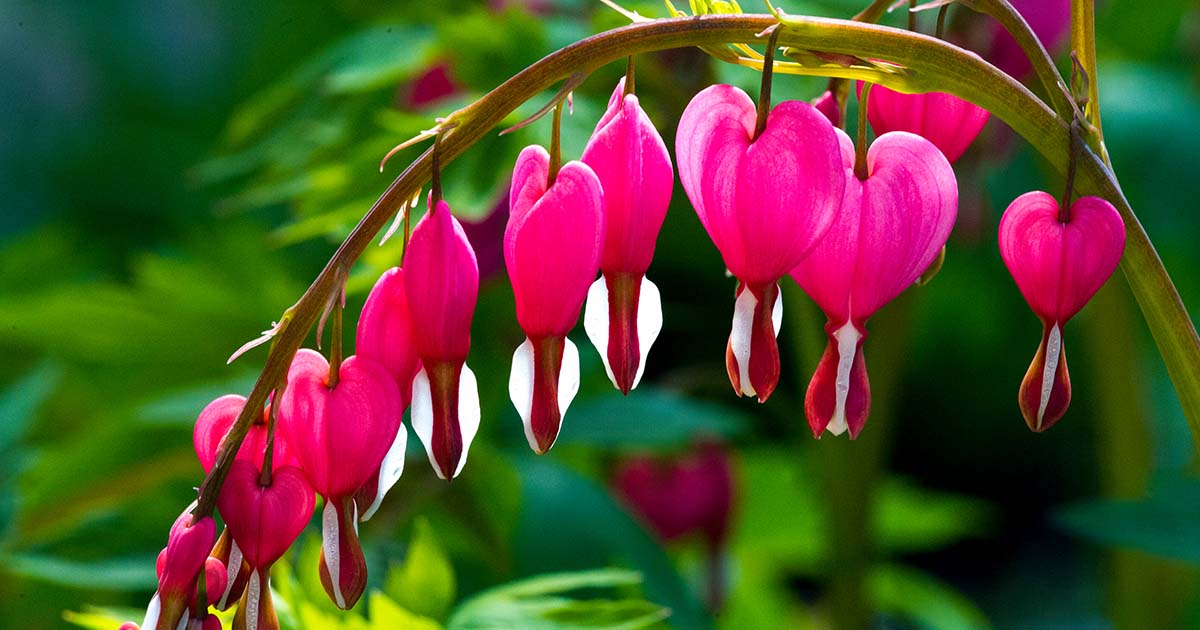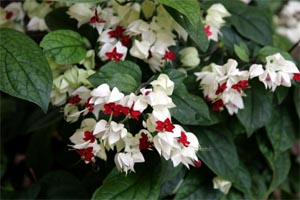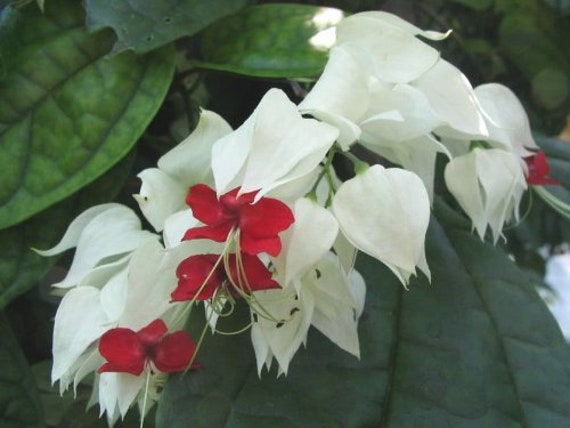The flowering plant Bleeding Heart Vine has two colors. If cultivated in containers and close to fencing, these tropical vine plants, which resemble bleeding hearts, are stunning and eye-catching. Among other vine plants, the bleeding hearts vine is a beautiful and well-liked specimen. They develop in a really attractive way, but to sustain them, you must wrap their veins around a wooden trellis.
Due to its lush green foliage and unique structural design, this plant is referred to as an evergreen subtropical plant. The primary factor in its rapid sales was its flowers, which come in two colors: red and white.
The outside petals of the flower are white, while the inner portion is crimson red in hue.
Generally speaking, people prefer it to be in a hanging basket, at which point its veins began to descend to the ground.
It looks incredible and this one may make your home and little garden even more beautiful.
Buy a plant called Bleeding Heart Vine.
PURCHASE CHECK IN AMAZON
ETSY PRICE CHECK
Aerial view of the Bleeding Heart Vine
There are numerous names for bleeding heart vine, including bleeding glory bower, glory tree, and bag flower. Clerodendrum thomsoniae is the scientific name for this vine plant, which belongs to the Lamiaceae family.
These plants were found in the tropical region of western Africa. It is a plant that has been around for a very long time.
It can grow to a maximum height of 3 to 3.5 meters, according to National Parks (11 to 11.5 feet). It contains black fruit that resembles drupes (fleshy thin skin).
These vein plants are utilized as aesthetic elements in both indoor and outdoor environments.
Short Facts
| Scientific Name | Clerodendrum thomsoniae |
| Common Name | Bleeding heart vine Bleeding Glory Bower, bagflower, beauty bush |
| Family | Lamiaceae |
| Native | West Africa |
| Type | Tropical Evergreen |
| USDA hardiness | Zone 9 to 11 |
| Height | 9-11 feet (over 3.5 m) |
| Spreads | 20-23 inches(over 55 cm) |
| Blooming Season | End of Spring to Summer |
| Soil | Well draining & moist |
| Light | Partial Shade to Sunlight |
| Medium to grow | Container or Garden |
| Fertilizer | Liquid Fertilizer |
| Propagation | Stem Cutting |
| Toxicity | Yes, they are Poisonous |
Table of Contents
How to Grow Bleeding Heart Vine (Clerodendrum thomsoniae)
To grow these vine plants, you must ensure that the temperature does not go below 48° (8°C), and the hardiness zone recommendation is 9 or higher.
The Need Potting mix soil for the plant’s overall growth requirements, and check that the pot you use has enough holes for water to easily drain.
Every 5 to 6 weeks, it needs to be pruned to remove the faded or pale stem and dead leaves.
If you like, you can prune the excess vines that are stopping the growth of the larger vines in order to encourage the growth of the other long vines.
Don’t worry if you clip a few of the veins because it will begin to develop more in the Spring. prior to spring.
Let me now list each of the parameters for greater growth one by one.
Light
They can thrive in either full or partial sunshine, but it’s preferable to give them six hours of direct sunlight daily.
They must receive the right amount of light in order to create flowers; otherwise, you won’t be able to view their blooms.
Temperature
They prefer environments that are above 49 to 55°F (10-13°C). USDA hardiness zones 10, 11, and 12 are preferred.
Water
You can water them every day, but first you need make sure they are still in moist soil.
If they are in damp soil, leave them alone, and sprinkle water on them as needed to meet their daily demands.
It takes more watering as they mature and grow.
Fertilizer
These vine plants require substantial dosages of plant food for the growth of their flowers. We are aware that slow release fertilizer, which can be applied every 55 days, performs the best.
Since it is liquid, you won’t have to put forth a lot of effort.
If you decide to buy additional fertilizer, I advise you to check to see if it has a lot of organic calcium added as plant food.
Soil
With pots that have the appropriate drainage holes, the soil can be effectively drained. Mix organic compost into the soil for healthy soil.
Repotting
When there is no more room in the preceding plant, repotting is necessary.
If your pot doesn’t already have holes in it, you can use one that is one to two sizes larger to plant your bleeding heart vine.
How to Care Bleeding Heart Vine (Clerodendrum thomsoniae)
During hot days, check on this vine plant to see if it needs water because it can feel dry and even the soil can dry out.
Don’t let them stand in a deluge of water, just moisten them with water.
Buy a plant called Bleeding Heart Vine.
PURCHASE CHECK IN AMAZON
ETSY PRICE CHECK
When it comes to fertilizer, these plants are ravenous for soil food. They want to grow blossoms, so fertilizer is necessary for them. It also needs plant food every 55 to 60 days.
It can withstand a variety of pest situations, but if you still experience pest issues with this vine plant, apply insecticidal soap spray to get rid of pests like mealybugs and spider mites, which can harm the plant’s leaves and stem.
Until all pests have been eliminated, this pesticide can be used every 8 to 11 days.
How to Propagate Bleeding Heart Vine (Clerodendrum thomsoniae)
You only need to cut this vine plant’s stem to start a new plant in order for the cutting to be effective and disease-free.
Use a sterilized cutting instrument to perform a precise cut without harming the already-existing plant. Start getting ready for the pot mixture by cutting any stem that is 3 to 5 inches long from the base.
Peat moss and perlite can be combined to create the greatest potting soil. After placing the mixture in a fresh pot, water it thoroughly until water begins to emerge from the soil.
Prepare a hole in the ground, place your cutting inside, and wait 4-5 weeks for the plant to begin growing properly.
Once a root system has developed, the plant’s growth can soar. If you see that the pot is too small, move the plants to another one.
How to prune Bleeding Heart Vine (Clerodendrum thomsoniae)
You should proceed to prune it if you spot any of these things.
It is best to very lightly clip vines, and if you want a vine to grow long, remove the shorter ones to make room for the bigger ones to grow.
Always use a clean, sterile tool when pruning, cutting, or trimming plants.
Bleeding Hearts Flower Meaning
I have described the significance of this lovely blossom. View More.
Most Search Questions
toxic bleeding heart vine According to NC State University, bleeding heart vine is poisonous with a low level of severity, which indicates that when taken by people, it can result in vomiting, respiratory problems, diarrhea, and mild skin irritation. Every part of this deadly wildflower is poisonous to humans.
hanging basket with bleeding heart vine These plants appear stunning in a hanging basket, and their tendrils grow till they touch the ground, which is really attractive. They can be installed on balconies and tiny garden homes.
Selling bleeding heart vine This plant sale is visible in both offline and online stores, and it is accessible in every nation. I can even give individuals who wish to purchase them links to some reliable websites.
How may bleeding heart vine cuttings be grown? They are really simple to grow from cuttings; all you need to do is cut off 3 to 4 inches of the bottom of the stem and put it in fertile soil. Don’t worry about the plant’s immediate growth; once it begins to develop roots, that’s when it will start to grow longer.
seeds of the bleeding heart vine If you want to buy seeds, you can do so from this website. For those who are interested in growing it from seeds, it is recommended to sow them at the end of summer so that it can flourish in winter because they start out in a wet environment. Since seeds need time to germinate, they require a cool temperature, as well as a high level of humidity. Since these seeds can grow and you can even slow their germination in the spring, the indoor atmosphere is suitable for growing these seeds.
Heart-bleeding vine trellisYou can purchase trellis from this site if you wish to. For those wondering how it will appear and why it is required to ensure that its vines can expand completely. You can grow several vines in the same pot with trellis, and you can control it with trellis.
Invasive bleeding heart vine This plant is invasive and toxic in every way, so if someone accidentally consumes any of it, they could get sick. Although touching it won’t hurt a person, you should wash your hands afterward.
Heart-bleeding flower It does contain flowers; in fact, it is one of the vine plants that bears them, and each of the flowers’ two distinct colors and attractive color combinations make it a particularly attractive and well-liked option among gardeners. It has red and white coloring and grows quickly.
FAQ’s
What degree of poison are bleeding hearts? Yes, this plant is dangerous, and if someone consumes it by accident, they could experience a lot of problems. According to NC State University, these symptoms include diarrhoea, vomiting, difficulties breathing, and some skin concerns. It is a wild plant with a low level of toxicity.
Bleeding Hearts climb, do they? The more it grows, the more vines it spreads, and whatever it sees, it climbs on those vines or just moves on to avoid the thing. In order for it to grow a good, long vine that is lovely and vibrant when its blossom blooms, you can utilize a trellis.
Does a trellis help bleeding hearts grow? Yes, a trellis is necessary for bleeding hearts to grow longer and spread higher. A trellis enables the heart vine to climb up walls and spread out wider with its leaves. To ensure that it grows larger and taller, trellis is utilized. Additionally, with that, it can receive adequate sunshine and be pruned.
Are dogs harmed by bleeding hearts? It can be toxic to animals like dogs and cats because it is toxic to humans. Don’t place these plants in front of a cat or dog because if they consume them, they might become ill and vomit. If this occurs, seek assistance from the local animal shelter.
Do bleeding hearts grow in number? Yes, roots spread readily and can even be multiplied by cuttings. They can also be planted in places where they receive adequate sunlight.
Deadhead bleeding hearts, do you? If you notice any dead or pale leaves, you can deadhead them; cutting the bleeding heart will revive its growth. Don’t cut off extra stems; just the overgrown or unsightly portions need to be pruned.
Do bleeding hearts withstand direct sunlight? Yes, it may grow in full sun, half sun, and partial shade. However, you must be sure to hydrate it frequently so that it stays moist and employs an appropriate soil combination for water drainage.
What is the lifespan of Bleeding Hearts? This plant can reproduce and grow again from its stem, making it long-lived until it contracts a disease. Vine plants are robust and have excellent growth.
Do hummingbirds enjoy a good heart attack? Hummingbirds come and perch on the stem of bleeding hearts because they enjoy this vine plant, so yes, they do prefer bleeding hearts. Because of its flower’s lovely and pure color, it is quite alluring to them.
Can bleeding hearts be planted in pots? Yes, it grows in pots, and you must repot it as it gets bigger. However, this plant won’t thrive unless you give it sufficient care, such as watering, feeding, providing it with the right amount of sunlight, and using a trellis. They can also be grown in gardens, where they spread more widely and proliferate more quickly. There is also good water retention.
Conclusion
What Makes This Variety of Sugar Baby Watermelon Special? [Growing Guide]
How to Grow, Take Care of, and Where to Plant Blue Eyed Grass (Sisyrinchium)
Grow, Take Care of, Procreate, Prune, and Toxicity of Blue Oat Grass [Full Guide]
Hawaiian Ti Plant: Where to Grow, When to Care for, Prune, and How to Procreate[Tips]



